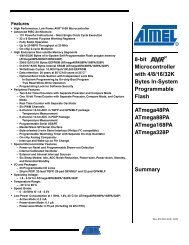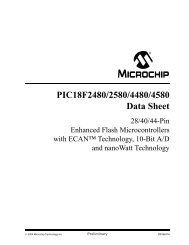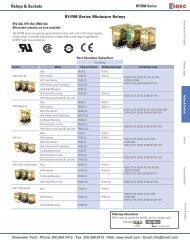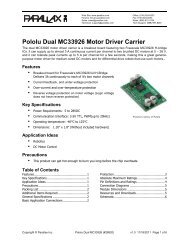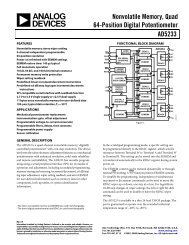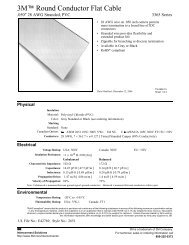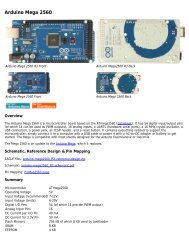FLEX 10KE Embedded Programmable Logic Device Data Sheet
FLEX 10KE Embedded Programmable Logic Device Data Sheet
FLEX 10KE Embedded Programmable Logic Device Data Sheet
Create successful ePaper yourself
Turn your PDF publications into a flip-book with our unique Google optimized e-Paper software.
<strong>FLEX</strong> <strong>10KE</strong> <strong>Embedded</strong> <strong>Programmable</strong> <strong>Logic</strong> <strong>Device</strong>s <strong>Data</strong> <strong>Sheet</strong><br />
The programmable flipflop in the LE can be configured for D, T, JK, or SR<br />
operation. The clock, clear, and preset control signals on the flipflop can<br />
be driven by global signals, general-purpose I/O pins, or any internal<br />
logic. For combinatorial functions, the flipflop is bypassed and the output<br />
of the LUT drives the output of the LE.<br />
The LE has two outputs that drive the interconnect: one drives the local<br />
interconnect and the other drives either the row or column FastTrack<br />
Interconnect routing structure. The two outputs can be controlled<br />
independently. For example, the LUT can drive one output while the<br />
register drives the other output. This feature, called register packing, can<br />
improve LE utilization because the register and the LUT can be used for<br />
unrelated functions.<br />
The <strong>FLEX</strong> <strong>10KE</strong> architecture provides two types of dedicated high-speed<br />
data paths that connect adjacent LEs without using local interconnect<br />
paths: carry chains and cascade chains. The carry chain supports<br />
high-speed counters and adders and the cascade chain implements<br />
wide-input functions with minimum delay. Carry and cascade chains<br />
connect all LEs in a LAB as well as all LABs in the same row. Intensive use<br />
of carry and cascade chains can reduce routing flexibility. Therefore, the<br />
use of these chains should be limited to speed-critical portions of a design.<br />
Carry Chain<br />
The carry chain provides a very fast (as low as 0.2 ns) carry-forward<br />
function between LEs. The carry-in signal from a lower-order bit drives<br />
forward into the higher-order bit via the carry chain, and feeds into both<br />
the LUT and the next portion of the carry chain. This feature allows the<br />
<strong>FLEX</strong> <strong>10KE</strong> architecture to implement high-speed counters, adders, and<br />
comparators of arbitrary width efficiently. Carry chain logic can be<br />
created automatically by the Altera Compiler during design processing,<br />
or manually by the designer during design entry. Parameterized functions<br />
such as LPM and DesignWare functions automatically take advantage of<br />
carry chains.<br />
Carry chains longer than eight LEs are automatically implemented by<br />
linking LABs together. For enhanced fitting, a long carry chain skips<br />
alternate LABs in a row. A carry chain longer than one LAB skips either<br />
from even-numbered LAB to even-numbered LAB, or from oddnumbered<br />
LAB to odd-numbered LAB. For example, the last LE of the<br />
first LAB in a row carries to the first LE of the third LAB in the row. The<br />
carry chain does not cross the EAB at the middle of the row. For instance,<br />
in the EPF10K50E device, the carry chain stops at the eighteenth LAB and<br />
a new one begins at the nineteenth LAB.<br />
18 Altera Corporation



